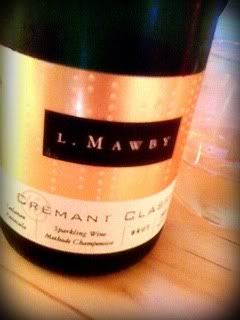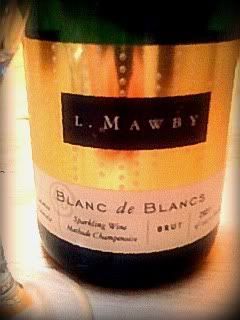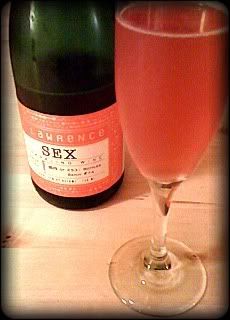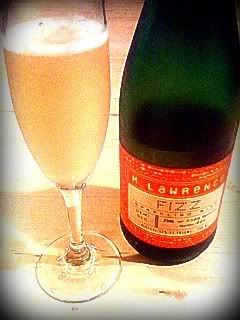In an interview with the wine blog "Michigan By The Bottle," Linda Jones, the Executive Director of the Michigan Grape and Wine Industry Council, says over the past decade, the wine industry in Michigan has grown ten to fifteen percent each year. She says Michigan is the eighth largest producer of wine grapes in the U.S.
Suttons Bay, Michigan is in the northwestern portion of the Lower Peninsula of Michigan, just east of Lake Leelanau. The tiny town is about halfway up the eastern shore of the Leelanau Peninsula. It sports a Farmers Market, a lighthouse, a state park, a casino and a handful of small wineries, including one that's unique, in that it only makes sparkling wines.
L. Mawby Vineyards - and their M. Lawrence label - produce 14 different sparkling wines, many of them made from the traditional grapes for bubbly: Chardonnay, Pinot Noir and Pinot Meunier. They do produce one sparkler made from Vignoles, a hardy grape that thrives in cold weather.
Of the four Michigan bubblies I tried - kindly supplied by L. Mawby Vineyards - two bear the L. Mawby label and were produced using the méthode champenoise, in which the wine undergoes a secondary fermentation in the bottle. The two wines under the M. Lawrence flag are produced in the méthode cuve close, in which the secondary fermentation takes place in a closed tank.
L. Mawby Vineyards produces 14 different sparkling wines, and all but one are non-vintage efforts. Their top of the line entry - the 2002 Mille - is $50, but most of their offerings sell for between $13-$22. The two L. Mawby wines received a brut dosage of 0.8 percent residual sugar, while the M. Lawrence Sex received a slightly higher brut dosage of 1.4 percent RS. The final wine I'll mention, M. Lawrence Fizz, is finished with a Demi-Sec dosage of 3.5 percent RS.
These wines, as different as they are, are all very well made and are quite impressive.
 The L. Mawby Cremant Classic is made from 100% Leelanau Peninsula Vignoles from the Cremant Vineyard. It's an impressive wine, with frothy white bubbles, sweet citrus notes and almonds on the nose, lots of nuts in the flavor profile and a pleasant lemony feel on the palate. It shows a very pleasant sensation of ginger beer on the finish. The grapes used in making this wine - and the other three I'll mention - are hand-harvested and whole cluster pressed. Only the cuvée - the initial, gently pressed juice - is used in making the Cremant Classic. It retails for $22.
The L. Mawby Cremant Classic is made from 100% Leelanau Peninsula Vignoles from the Cremant Vineyard. It's an impressive wine, with frothy white bubbles, sweet citrus notes and almonds on the nose, lots of nuts in the flavor profile and a pleasant lemony feel on the palate. It shows a very pleasant sensation of ginger beer on the finish. The grapes used in making this wine - and the other three I'll mention - are hand-harvested and whole cluster pressed. Only the cuvée - the initial, gently pressed juice - is used in making the Cremant Classic. It retails for $22. L. Mawby Blanc de Blancs - like the Cremant Classic - is also produced in the méthode champenoise. It's a non-vintage sparkler of 100% Chardonnay from the Leelanau Peninsula AVA. Only the cuvée is used and it is bottle fermented and aged a minimum of 24 months. This wine sports a nutty nose with lemon-lime citrus notes and a yeasty feel on both the nose and palate. It's bright and festive, and retails for $19.
L. Mawby Blanc de Blancs - like the Cremant Classic - is also produced in the méthode champenoise. It's a non-vintage sparkler of 100% Chardonnay from the Leelanau Peninsula AVA. Only the cuvée is used and it is bottle fermented and aged a minimum of 24 months. This wine sports a nutty nose with lemon-lime citrus notes and a yeasty feel on both the nose and palate. It's bright and festive, and retails for $19. The M. Lawrence Sex is a rosé bubbly made from 75% Pinot Noir and 25% Chardonnay grapes. This one is a tad sweeter, getting a Brut dosage of 1.4% RS. Again, only the cuvée is used, but this wine is produced using cuve closefermentation - receiving its second fermentation in a closed tank.
The M. Lawrence Sex is a rosé bubbly made from 75% Pinot Noir and 25% Chardonnay grapes. This one is a tad sweeter, getting a Brut dosage of 1.4% RS. Again, only the cuvée is used, but this wine is produced using cuve closefermentation - receiving its second fermentation in a closed tank.It is aptly named, as the wine is sexy looking, with a deep pink rosato-style coloring and those frothy white fine bubbles, this time with a nose of cherry candy and strawberries. Very fruity aromas mingle with a slight herbal edge and a bready nose. The taste is vivid and bright, bursting with flavor and acidity. An extremely refreshing mouthfeel sports a touch of earthiness on the finish. It is extremely drinkable and extremely food-friendly. You'll find it's a little sweeter than the Cremant and the Blanc de Blancs but just barely so, with 1.4 percent residual sugar. The retail price of Sex is $15, a bargain.
 Fizz is also under the M. Lawrence label, and it's their sweetest sparkling wine. Produced from 75% Pinot Noir and 25% Chardonnay grapes, Fizz differs from the other three L. Mawby wines I tasted, in that the tailles juice is used - the second fraction of juice pressed, after cuvée - and it's finished with a Demi-Sec dosage, 3.5% RS.
Fizz is also under the M. Lawrence label, and it's their sweetest sparkling wine. Produced from 75% Pinot Noir and 25% Chardonnay grapes, Fizz differs from the other three L. Mawby wines I tasted, in that the tailles juice is used - the second fraction of juice pressed, after cuvée - and it's finished with a Demi-Sec dosage, 3.5% RS.Fizz is honey-golden in color with a honey aroma on the yeasty apricot nose. There's a slight taste of honey on the palate, too, but it’s not anywhere near overly sweet. The finish is long and satisfying. Fizz is sold for $13 retail.
The Wine Country stop in Michigan gave us four wonderful sparkling wines with ten more on the L. Mawby menu to try. These wines are special enough to save for special occasions, but why wait? Every day is special in its own way.
Follow Randy Fuller on Twitter



 The 1200 growers in Toro produce wines which have a much darker fruit expression in than those found in in Rioja. Most of the wines tasted at this seminar were between 14% and 15.5% in alcohol content. Toro has whites made from Verdejo and Malvasia. Garnacha is also employed here, but the reds are all about Tinta de Toro, and this tasting was all about the reds.
The 1200 growers in Toro produce wines which have a much darker fruit expression in than those found in in Rioja. Most of the wines tasted at this seminar were between 14% and 15.5% in alcohol content. Toro has whites made from Verdejo and Malvasia. Garnacha is also employed here, but the reds are all about Tinta de Toro, and this tasting was all about the reds. The Wines:
The Wines:


 Biltmore Reserve Chardonnay 2009 North Carolina
Biltmore Reserve Chardonnay 2009 North Carolina Biltmore Estate Château Reserve Blanc de Blancs 2008 North Carolina Méthode Champenoise Brut
Biltmore Estate Château Reserve Blanc de Blancs 2008 North Carolina Méthode Champenoise Brut



 Cabernet Sauvignon Reserve 2007 Napa Valley
Cabernet Sauvignon Reserve 2007 Napa Valley Sauvignon Blanc 2009 Napa Valley
Sauvignon Blanc 2009 Napa Valley



 Sawtooth Winery Reserve Carmenénère 2009
Sawtooth Winery Reserve Carmenénère 2009 Sawtooth Estate Winery Riesling 2009
Sawtooth Estate Winery Riesling 2009




 When there's a big roomful of winemakers present, you're going to hear a lot about grapes. You're going to hear very deep discussions about grapes. You're going to find out how much you don't know about grapes. I had the chance to listen to Ken Volk talk about grapes at length with someone who appeared to be trying to dislodge Volk as the biggest grape geek in the room. Note to others: that's a game you won't win. Volk gave an impromptu botany lesson, ranging from DNA to grape origins to the genetic offspring of Muscat Alexandria. I was transfixed until the pourer looked at me and cocked his head toward Volk, saying "He can get geeky." 2010 was Volk's 34th vintage, so he has earned the right to be as geeky he wants to be.
When there's a big roomful of winemakers present, you're going to hear a lot about grapes. You're going to hear very deep discussions about grapes. You're going to find out how much you don't know about grapes. I had the chance to listen to Ken Volk talk about grapes at length with someone who appeared to be trying to dislodge Volk as the biggest grape geek in the room. Note to others: that's a game you won't win. Volk gave an impromptu botany lesson, ranging from DNA to grape origins to the genetic offspring of Muscat Alexandria. I was transfixed until the pourer looked at me and cocked his head toward Volk, saying "He can get geeky." 2010 was Volk's 34th vintage, so he has earned the right to be as geeky he wants to be. Ogorsolka boasted that his wines nearly all fall between 15 and 16% abv. Truly, that big bold wine is one of Paso's calling cards - and big, bold wines are okay in my book. Many people feel that such high alcohol levels are not food friendly. Some complain that wines like Pinot Noir simply aren't varietally correct in that rarefied air. There are also voices out there who maintain that high alcohol wine is flawed wine.
Ogorsolka boasted that his wines nearly all fall between 15 and 16% abv. Truly, that big bold wine is one of Paso's calling cards - and big, bold wines are okay in my book. Many people feel that such high alcohol levels are not food friendly. Some complain that wines like Pinot Noir simply aren't varietally correct in that rarefied air. There are also voices out there who maintain that high alcohol wine is flawed wine.

